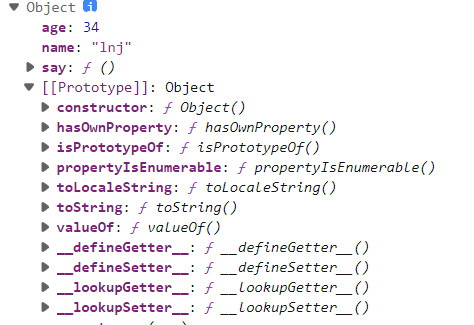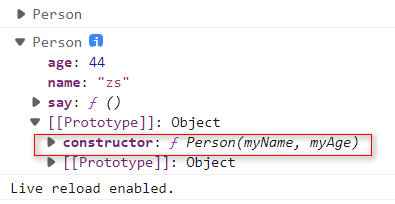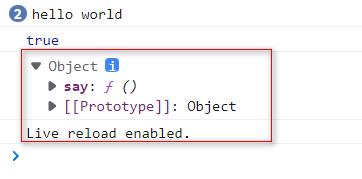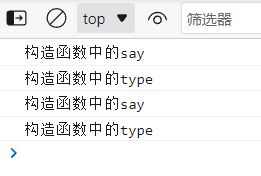JavaScript 构造函数由浅入深理解
分类:
日期:
2022-5-19标签:
1.从工厂函数说起#
什么是工厂函数?
工厂函数就是专门用于创建对象的函数, 我们就称之为工厂函数
一般我们会像下面这样,直接通过大花括号的形象创建一个对象
let obj = {name: 'lnj',age: 33,say: function () {console.log('hello world');},};let obj = {name: 'zs',age: 44,say: function () {console.log('hello world');},};
有时候我们可能需要一个特定结构的对象,这个对象结构在很多时候我们可能会复用,可以考虑工厂函数模式,像这样
function createPerson(myName, myAge) {let obj = new Object();obj.name = myName;obj.age = myAge;obj.say = function () {console.log('hello world');};return obj;}let obj1 = createPerson('lnj', 34);let obj2 = createPerson('zs', 44);console.log(obj1);console.log(obj2);
new Object() 与 不同之处在于,通过 new Object()出来的对象,并不是一个空对象,它会包含一个 Prototype 属性,该属性会包含很多对象内置的属性方法。
2.什么是构造函数#
构造函数和工厂函数一样, 都是专门用于创建对象的,构造函数本质上是工厂函数的简写
3.构造函数的实现及工厂函数的区别#
- 构造函数的函数名称首字母必须大写
- 构造函数只能够通过 new 来调用
先看下面的实现示例:
function Person(myName, myAge) {// let obj = new Object(); // 系统自动添加的// let this = obj; // 系统自动添加的this.name = myName;this.age = myAge;this.say = function () {// 方法中的this谁调用就是谁, 所以当前是obj1调用, 所以当前的this就是obj1// console.log(this.name, this.age);console.log('hello world');};// return this; // 系统自动添加的}
当我们 new Person("lnj", 34) 系统做了什么事情?
- 会在构造函数中自动创建一个对象 new Object();
- 会自动将刚才创建的对象赋值给 this
- 会在构造函数的最后自动添加 return this;
let obj1 = new Person('lnj', 34);let obj2 = new Person('zs', 44);console.log(obj1);console.log(obj2);// 由于两个对象中的say方法的实现都是一样的, 但是保存到了不同的存储空间中// 所以有性能问题// 通过三个等号来判断两个函数名称, 表示判断两个函数是否都存储在同一块内存中console.log(obj1.say === obj2.say); // false
可以看到输出的对象中有一个 constructor 属性。由于两个对象中的 say 方法的实现都是一样的, 但是保存到了不同的存储空间中,所以有性能问题。
4.构造函数优化#
我们上面提到,对于 say 方法, 每个对象都会保存一份会存在性能问题,浪费存储空间。那么可以考虑将它提取共用,不用每次 new 都创建一份。
function mySay() {console.log('hello world');}function Person(myName, myAge) {// let obj = new Object(); // 系统自动添加的// let this = obj; // 系统自动添加的this.name = myName;this.age = myAge;this.say = mySay;// return this; // 系统自动添加的}let obj1 = new Person('lnj', 34);let obj2 = new Person('zs', 44);console.log(obj1.say === obj2.say); // true
上面的输出 obj1.say === obj2.say 为 true, 似乎解决了问题,但当前这种方式解决之后也存在弊端
- 阅读性降低了
- 污染了全局的命名空间
我们在考虑将 say 放在一个对象中管理,避免上述问题
// function mySay() {// console.log("hello world");// }let fns = {mySay: function () {console.log('hello world');},};function Person(myName, myAge) {// let obj = new Object(); // 系统自动添加的// let this = obj; // 系统自动添加的this.name = myName;this.age = myAge;this.say = fns.mySay;// return this; // 系统自动添加的}let obj1 = new Person('lnj', 34);let obj2 = new Person('zs', 44);console.log(obj1.say === obj2.say); // true/*let fns = {test: function () {console.log("test");}}// 由于test函数都是属于同一个对象, 所以返回trueconsole.log(fns.test === fns.test); // true*/
由于 say 函数都是属于同一个对象, obj1.say === obj2.say 指向的都是同一个对象的空间地址,所以返回 true。
然而,这种方式似乎和我们使用中的不太一样,这种方式看起来也怪怪的。
我们考虑给 Person 构造行数添加一个属性 prototype 来保存我们要共用的 say, 看下面的代码
// let fns = {// mySay: function () {// console.log("hello world");// }// }function Person(myName, myAge) {// let obj = new Object(); // 系统自动添加的// let this = obj; // 系统自动添加的this.name = myName;this.age = myAge;// this.say = fns.mySay;// return this; // 系统自动添加的}Person.prototype = {say: function () {console.log('hello world');},};let obj1 = new Person('lnj', 34);obj1.say();let obj2 = new Person('zs', 44);obj2.say();console.log(obj1.say === obj2.say); // trueconsole.log(Person.prototype);
Person 构造函数本质也是一个对象,所以通过 prototype 属性保存公用的方法,也就是我们说的原型对象的方法,当 new Person()后,我们能通过 obj1.say() 访问到 prototype 中的 say 方法。其实 prototype 是构造函数内部的一个属性,这是 JavaScript 内部已经帮我们处理了的,也就是我们说的原型链这块上。
5.prototype 特点#
1.1 存储在 prototype 中的方法可以被对应构造函数创建出来的所有对象共享 1.2 prototype 中除了可以存储方法以外, 还可以存储属性 1.3 prototype 如果出现了和构造函数中同名的属性或者方法, 对象在访问的时候, 访问到的是构造函中的数据
看下面的代码, 加深上面的理解
function Person(myName, myAge) {this.name = myName;this.age = myAge;this.currentType = '构造函数中的type';this.say = function () {console.log('构造函数中的say');};}Person.prototype = {currentType: '人',say: function () {console.log('prototype中的say');},};let obj1 = new Person('lnj', 34);obj1.say();console.log(obj1.currentType);let obj2 = new Person('zs', 44);obj2.say();console.log(obj2.currentType);
可以看到,实例对象是先读取构造函数 this 上的属性和方法,而不是 prototype 上的
prototype 应用场景
prototype 中一般情况下用于存储所有对象都相同的一些属性以及方法 如果是对象特有的属性或者方法, 我们会存储到构造函数中



